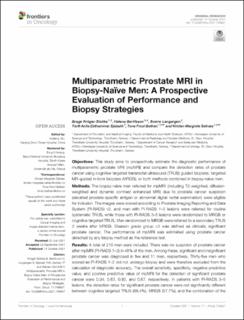| dc.description.abstract | Objectives: This study aims to prospectively estimate the diagnostic performance of multiparametric prostate MRI (mpMRI) and compare the detection rates of prostate cancer using cognitive targeted transrectal ultrasound (TRUS) guided biopsies, targeted MR-guided in-bore biopsies (MRGB), or both methods combined in biopsy-naïve men. Methods: The biopsy-naïve men referred for mpMRI (including T2-weighted, diffusion-weighted and dynamic contrast enhanced MRI) due to prostate cancer suspicion (elevated prostate-specific antigen or abnormal digital rectal examination) were eligible for inclusion. The images were scored according to Prostate Imaging Reporting and Data System (PI-RADS) v2, and men with PI-RADS 1–2 lesions were referred for routine systematic TRUS, while those with PI-RADS 3–5 lesions were randomized to MRGB or cognitive targeted TRUS. Men randomized to MRGB were referred to a secondary TRUS 2 weeks after MRGB. Gleason grade group ≥2 was defined as clinically significant prostate cancer. The performance of mpMRI was estimated using prostate cancer detected by any biopsy method as the reference test. Results: A total of 210 men were included. There was no suspicion of prostate cancer after mpMRI (PI-RADS 1–2) in 48% of the men. Among these, significant and insignificant prostate cancer was diagnosed in five and 11 men, respectively. Thirty-five men who scored as PI-RADS 1–2 did not undergo biopsy and were therefore excluded from the calculation of diagnostic accuracy. The overall sensitivity, specificity, negative predictive value, and positive predictive value of mpMRI for the detection of significant prostate cancer were 0.94, 0.63, 0.92, and 0.67, respectively. In patients with PI-RADS 3–5 lesions, the detection rates for significant prostate cancer were not significantly different between cognitive targeted TRUS (68.4%), MRGB (57.7%), and the combination of the two biopsy methods (64.4%). The median numbers of biopsy cores taken per patient undergoing systematic TRUS, cognitive targeted TRUS, and MRGB were 14 [8-16], 12 [6-17], and 2 [1-4] respectively. Conclusions: mpMRI, in a cohort of biopsy-naïve men, has high negative predictive value, and our results support that it is safe to avoid biopsy after negative mpMRI. Furthermore, MRGB provides a similar diagnosis to the cognitive targeted TRUS but with fewer biopsies. | en_US |

